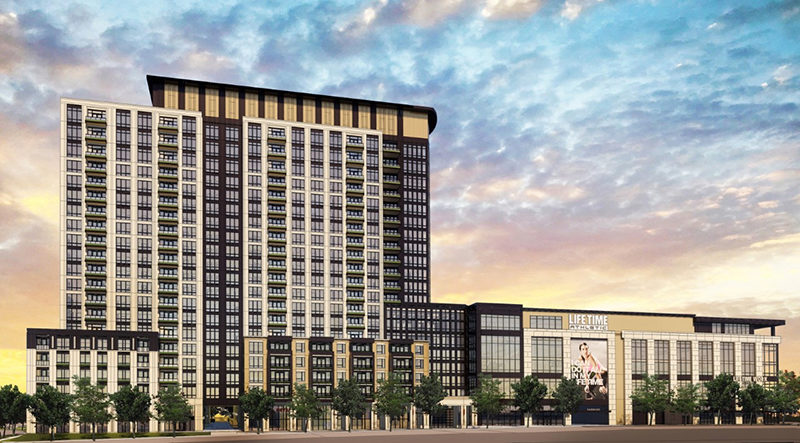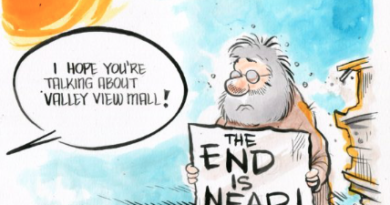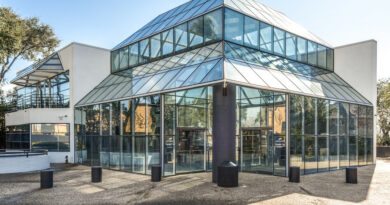A New Neighborhood For North Dallas
Once it was a popular mall and hangout, then it became a ghost town as newer, shinier malls took its place – but as all vestiges of the 46-year-old Valley View Mall are scraped from the 173-acre site it sat on for so many years, a neighborhood will emerge.
Scott Beck, whose Beck Ventures is one of three developers collaborating to create a neighborhood out of whole cloth, said the location is ripe for a cohesive, walkable community.
“I think one of the biggest things to keep in mind is this area of Dallas is at the center of the population density in Dallas – a third of the population lives within three and a half miles of Preston and 635,” he said. “So we want to make sure what we build is really a neighborhood.”
“And obviously in order to have a neighborhood, there have to be people living in it,” he added. “And right now, it’s substantially commercial – you have Valley View on one side, which doesn’t exist anymore, and the Galleria on the other, and some residential, but it’s substantially more commercial and retail.”
It’s estimated that more than 350,000 cars pass by the Midtown area via LBJ Freeway and Preston Road.
“(T)his area of Dallas is at the center of the population density in Dallas – a third of the population lives within three and a half miles of Preston and 635.” -Scott Beck
Beck Ventures has partnered with Life Time Inc. to create Life Time Living – high-end, leased residences with an aim at providing occupants with the tools needed for a healthy lifestyle. Life Time Midtown will include 390 one-and-two-bedroom apartments, with an additional 190,000-square-foot Life Time Athletic Club and 50,000-square-foot Life Time Work – a coworking space.
“(What) we’re starting with from a residential perspective is various price points of housing, all the way up to high rise housing,” Beck explained. “The Life Time Village, one of our first projects, we’ll be creating a 20-story ultra-luxury high rise, which will be connected to this $250 million Life Time Village.”
Beck said that the highlights include a three-acre beach pool amenity deck, and views of the tree-canopied Preston Road area.
Beck Ventures has also partnered with Toll Brothers, who will build 266 apartments as part of its holdings at the site. There will also be a hotel with 200 rooms and 40 condos and a new office building that will also be home to a new – and more luxurious – AMC Theater.
“And then as you get towards Montfort, there’s a new park that’s basically situated between our property, a main boulevard, and the Galleria,” Beck said. “And that new park is the Midtown Park, which will be four times the size of Klyde Warren.”
In addition to the apartments Toll Brothers is building with Beck Ventures, the company is also building apartments with Dallas developer KDC and New-York based Seritage Growth Properties, who also has an ownership stake in the Valley View site. Their mixed-use project called Park Heritage will total 300 luxury residential rental units with retail, entertainment, and dining, as well as 3 acres of open space.
More of our conversation with Scott Beck follows. It has been edited for clarity and length.
PN: We keep seeing stories about how many people are moving to the Dallas area, and how housing inventory continues to be lower than ideal, especially when you factor in what economists feel is a balanced market. Did that play into your decision to create more multifamily housing in the Midtown area?
Beck: “I think one of the biggest things to keep in mind is that this area of Dallas is at the center of the population density in Dallas. So a third of the population lives within three and a half miles of Preston and 635 – of Dallas Midtown. What we want to make sure we build is, is really a, a neighborhood. And obviously, in order to have a neighborhood, there have to be people living in the neighborhood. So Dallas Midtown predominantly right now is substantially commercial, right? You have the Valley View on one side, which doesn’t exist anymore, and the Galleria on the other and you have some, some residential, but it’s, it’s substantially more commerce, right? You’ve got Target, you’ve got doctor’s offices, you’ve got office buildings, you’ve got retail. I mean, that’s, that’s really what fits there.”
PN: And then a couple of little apartment complexes tucked behind there, just behind that Target, but nothing substantial.
Beck: “That’s correct. But I wouldn’t necessarily call it a neighborhood. And you have to recognize the fact that, that, you know, the old Valley View Mall site is over 100 acres, and when you think in comparison to the physical amount of land, if 100 acres of vacant land can be a neighborhood on, into itself, I mean, that’s the size Uptown – all of Uptown. So what’s incumbent upon us is to make sure that we actually create a neighborhood and in order to create any of that, obviously we need residential. And so, so what we’re starting with from a residential perspective is various price points of housing all the way up to high rise housing. In one of our first projects, the Life Time Village, we’ll be creating a 20 story ultra-luxury high rise apartment building called Life Time Living, which will be connected to this $250 million Life Time Village.
It will all be sitting on Preston Road where the old car dealership was, right? So that’s between the entrance at Dilbeck and where the Dunkin Donuts is still today. And so on that property, you’ll have close to 75,000 square feet of restaurant and retail on the ground level. On the second floor of that building, you’ll have 50,000 square feet of Life Time Work, which is collaborative office space, not too dissimilar to WeWork, but it’s Life Time’s version of that. And then on the third level, you’ll have the Life Time Athletic, which is 130,000 square feet of athletic and fitness. And then centered on the top of this village is a 3-acre beach pool amenity deck, with gorgeous views looking out, you know, across Preston Road, and off to the west, with all the tree canopy.
So that’s, that’s kind of one price point, but we’re also building two additional apartment buildings on the property, um, all along this main street. So from a Dallas perspective, people understand what, like the new Legacy West is with this main boulevard, right? If you give them an example of Legacy West where you’ve got the Shops of Legacy with, with the ground floor either entertainment or retail types of ground floor. And then you’ve got apartments and office buildings sitting on top that, that’s what this main street coming from, the corner of Dilbeck and Preston, and then bisecting the property all the way across to Montfort and Peterson, which is where the Chuck E Cheese is today.
So now you can build a road that goes straight through the property cause there’s no mall anymore. And then on either side of this new road is all of this ground floor, retail and, and apartment buildings, the new AMC, the Life Time Village, and a hotel.
And then as you get towards Monfort there’s a new park that’s basically situated between our property where we’re building this main boulevard and the Galleria. And that new park is the Midtown Park, which, which will be four times the size of Klyde Warren.”
PN: So obviously, you’re hoping that families are among those moving into this new neighborhood, with the park and the green space, and the potential to never have to get out of your car. But what do you see being the impact on the schools around there?
Beck: “What’s going on at Dallas Midtown is more than just the Valley View Mall redevelopment – it’s the largest urban district rezone in the history of the city. So the city has not only rezoned where Valley View Mall has been rezoned, they rezoned all the property from Preston Road to the Galleria. So it’s all inside this Midtown district, and as part of that, and as part of the new bond election Dallas ISD wants to do, they want to earmark $79 million for a new pre-K through 12 STEM school. And that would be a vertical school – so it would be very different than a lot of the other schools that exist today.
I’ve not had direct conversations with Dallas ISD, but I do know that the basic goal of looking at a K through 12 school is looking at the demographics of who is in the North Dallas area. And there are a lot of private schools, and most private schools are pre-K through 12. So the idea is providing a public option that is a similar model to a private school environment. that doesn’t mean that the children going there are the same children that are in private school, but the idea is that we listen to what educators say from around the country, and being able to have a school that has multiple socioeconomic backgrounds within the same environment is a healthy school.
So by creating a model that is commensurate with the private schools in this area, the goal would be, I think, to entice some of the parents to take a look at this DISD school? I think it’s a really interesting project, because it could very well be an interesting model to try to emulate on a go-forward basis.
There’s no question that the Dallas ISD trustees, over the past five years or so, have made tremendous strides. And I personally applaud the district for that work. I think Dallas is no different than any major metropolitan cities across the United States as it relates to education. It’s a perpetual struggle and obviously an issue we have in the DFW metroplex is we have a lot of land exterior to the city of Dallas. And so you’ve got a suburban sprawl.
This is a really good step towards the vision that our trustees set out to try to create an environment where all socioeconomic strata are willing to, dare I say, cohabitate within that school system, we will have a much stronger school system.”
PN: There’s been a lot of talk about density and how we should be looking holistically at neighborhoods – at the impact a development has on one, or even if we’re creating a whole neighborhood that people can really take ownership of. Do you think that the Midtown project addresses those desires and some of those discussions about best practices in urban planning?
Beck: “Yes, I do. I do. Absolutely. And it all starts with planning. So some of the ills that we’ve had in the downtown Dallas area is that grew up over time, right? So Uptown didn’t start with a plan, Uptown started with people building apartment buildings, and then, you know, you fast forward 20 years and they’re trying to figure out how to change the direction of streets. How do you squeeze in a trolley system, those types of things.
Midtown, we did a different model. We took the best practices of the Urban Land Institute, and then over the past eight and a half years came up with a strategy that could be executed over the next two decades. Uh, and so, so it started with the plan. It started with the rezone, it started with a traffic impact analysis, it started with homes and now we’re ready to actually start building.
It’s part of the reason why we came up with the idea of creating a larger program park that anything Dallas has ever seen – four times the size of Klyde Warren – in quite frankly, the center of the population density. The densification, the vertical densification in this area, as we know, Dallas is not like Houston. So by doing this just north of 635, we can create major density without disrupting our suburban feel in parts of North Dallas. But at the same time, capturing that significant amount of tax base for the city of Dallas.
When you get past this area, you start to get into Richardson and Addison. And so that’s the biggest problem from a Dallas perspective. And really it’s driven by corporate users. Corporate users seem to continue to want to go North. So the question is, is how do we, as a city, create an environment where we give them an alternative destination to downtown Dallas that is still in Dallas, because not everybody wants to live downtown necessarily.”









What’s with the name “Midtown”? I thought that was North Dallas?